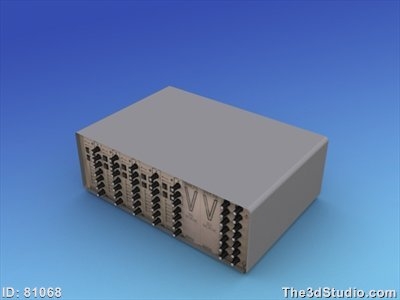Allan Leibowitz, chief editor of Digital Drummer Mag, had one of the rare opportunities to make an interview with Dave Simmons. In a very open manner Dave reflects upon the “good times” back in the 80s, the “bad times”, Simmons’ influence on today’s electronic drums and also his conflicts with Guitarcenter.
Archive for the ‘Stories and Gossip’ Category
Interview with Dave Simmons on Digital Drummer Mag
Tuesday, April 26th, 2011Posted in Report, Stories and Gossip | 7 Comments »
Virtual SDS
Tuesday, June 22nd, 2010Although unexpectedly many SDSV brains and pads appeared on Ebay, I am sure that not everyone who has been desperately looking for an SDSV could get his personal instance. Anyway here is a virtual substitude:
This “unit” can be purchased at 3dstudio.com as a scalable polygon file. Probably this can be combined with a virtual SDSV sound library in the near future?
Posted in Brains, Report, Stories and Gossip | 1 Comment »
Living in a box
Wednesday, May 12th, 2010It’s about time for a nearly senseless post: The boxes….
Normally I keep boxes only if the cats or the kids want to keep them for playing or handicrafts. Only if the boxes say “Simmons” or “Musicaid” I don’t have the heart to give them away:

This topic even got a passage in the Complete Simmons Drum Book by Bob Henrit:
“… They had a problem too when it came to packing them for shipment. None of the work force of two or three had much idea about packing musical instruments! The first set they ever sent to Germany was delayed because they didn’t possess anything to send it. The early Simmons days were fraught with all sorts of these setbacks, but fortunately SDS3 was still selling very, very well. …”
You may look forward to the next post. It will be at least as senseless 🙂
Posted in Misc, Stories and Gossip | 3 Comments »
The legendary Simmons head kit
Wednesday, November 4th, 2009When Simmons started producing the SDSV, a sculptor named Coleman Saunders, friend of Dave Simmons, built a handfull of custom shaped drum pads compatible with the SDSV. Basically it was intended to attract the crowd for the whole Simmons product line. It was never intended to become a mass product like the SDSV. A picture of this headkit was printed on the backside of the one and only SDSV catalogue:
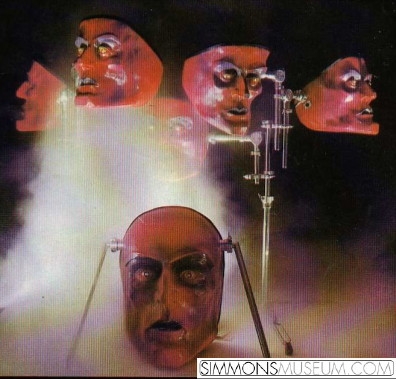
This headkit was recently made a subject of a discussion in the Simmons newsgroup. Reason enough for me to sum up the scanty documentation about these kits. Bob Henrit wrote in the Complete Simmons Drum Book:
“…The shapes which epitomise the possibilities of Simmons customising, have to be the ones which resembled ‘human heads’. (They were actually made as a publicity stunt, to sell more than one regular sets.) They were modelled in fibreglass, by an artist friend of Dave’s named Coleman Saunders, and were evidently inspirde by the Presidents heads at Mount Rushmore. Two clay ‘masters’ were made from which a pair of rubber moulds were fashioned which ultimately went on to produce something like ten sets. They were available in red, blue and yellow upon which Dave simmons did a great deal of airbrush work and fitted with cut-glass eyes. Evidently they all turned out to be slightly different. The top of the cranium was sliced through to fit the wood and ‘riot shield’ playing surfaces. These of course needed to be fitted as usual with aluminium edging strip which was no mean feat. (The shape of human head is not particularly regular as I’m sure you’re aware!)…”
At least two music videos are known to feature a Simmons head kit. First is Landscapes ‘Einstein A Gogo’:
Second is Felony’s ‘The Fanatic’ (although the drum sound definetely comes from acoustic drums ;-)):
Finally a small anecdote that Baz Watts, former keyman of Simmons Electronic Drums, told me: When they took the photo of the head kit for the SDSV flyer, they did not have a working fog machine. On the spot they set the paper bin on fire. So what you see in the picture is no fog but real smoke coming from a burning paper bin…
Posted in Pads, Report, Stories and Gossip | 2 Comments »
The Complete Simmons Drum Book
Thursday, October 22nd, 2009I think it is not exeggarated to say that the Complete Simmons Drum Book is the holy bible for every Simmons fan. Even more since this book is not available anymore. It was written around 1987 by professional drummer/editor/tester Bob Henrit. It tells the full story of Dave Simmons and his Companies “Musicaid” and “Simmons” from the very beginning until the announcement of the SDX.
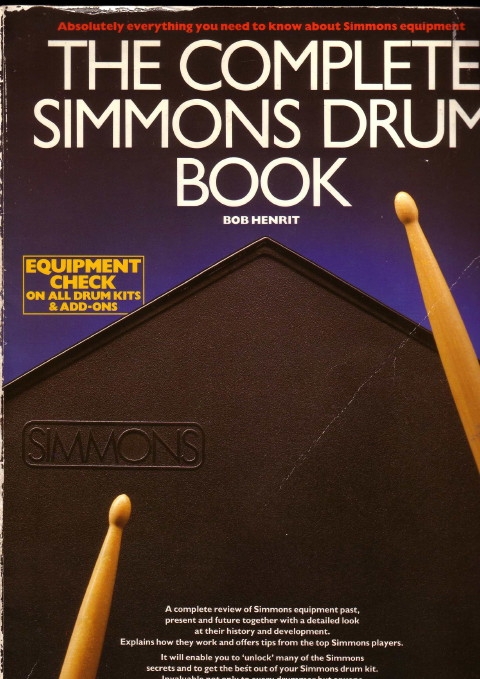
As I am no contemporary witness of this period, I am really glad to possess my very personal copy. It cost something around 50 Euro. Probably today the only source to obtain essential information about at least the first (and better) half of the company’s history.
To get to the heart of this post: I really wanted to provide a PDF version on my site for free, but a book is more than a catalogue or an advertisement and I did not want to hurt anybody’s rights. So I contacted the auther Bob Henrit to discuss the idea of making it puplic domain. Unfortunately he was aversed to this idea what I absolutely respected. He preferred the idea to distribute it with a required fee. But my policy is to keep my site non-commercial, so I refused. In my opinion a fee would have reduced the number of readers (and the expected sales) to a very minimum.
The only thing I can tell is if you have the chance to get your hands on a copy: Take it. It was expensive, but is still worth every cent. Promised.
Posted in Misc, Recommendation, Report, Stories and Gossip | 6 Comments »
Have I been messed up in the 80s?
Saturday, October 17th, 2009Today I heard on the radio about the reunion and the upcoming tour of 80s cult band Spandau Ballet. I guess I was 12 when their first chart breaking single “True” has been released. John Keeble sat behind a pure white SDSV kit with even two bassdrums. However I was also wondering why he was always playing acoustic drums on live pictures and videos. 25 years later I heard him say in an interview that the only track they ever used Simmons sounds for was “Chant No. 1”. It was all an illusion! John got his Simmons by Dave Simmons personally. Serial number 3! AND HE ALMOST DIDN’T USE IT FOR RECORDINGS? Unbelievable. A reason to feel messed around? No. Much less artists really used Simmons drums on their recordings as those who affected using Simmons due to pounding on hexagonal pads in front of a camera. The Linn 9000 was used on records much more often. Still I have to state that Simmons drums and the MTV age stimulated each other very much. Both were a stroke of luck for each other.
I must admit that I was (and I am still) one of those who were more blinded by the design than by the sound. I became aware of what the Simmons sound is actually about much later. Still there were enough artists that established the sound also on countless recordings. So what… I think I wouldn’t have hasitated to use Simmons pads on “Top Of The Pops” as this really had the potential to accelerated the record sales. And I am really thinking about getting myself a ticket for a Spandau Ballet show, also in order to ask John Keeble to sign on one of my pure white beauties 😉
Good night
Posted in Report, Stories and Gossip | 7 Comments »
Simmons and the plagiarisms
Monday, October 12th, 2009I recently won an auction where 2 vintage hexagonal shaped pads had been offered. Although the description did not say anything about “Simmons”, the picture really made me believe that they were. Finally I got these two pads for a reasonable price of 1 Euro. Yes, a bargain. But when they finally arrived, I was very astonished what I had actually bought: Two pads manufactured by a polish company named “Polmuz” (“POLish MUZak”):
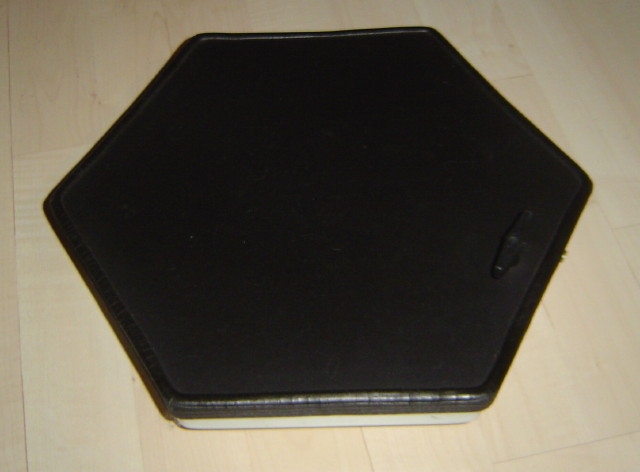
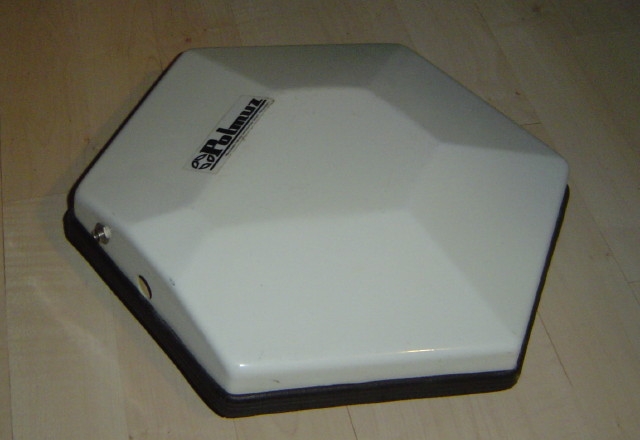
I was not disappointed at all knowing that I probably got something that might have been even rarer than any other Simmons pad I already owned. An almost 1:1 copy of the SDS7’s MKIII pads. Today I could hardly resist when I saw another two pads of a U.S.S.R. manufacturer named “LELL”. Just the same as my Polmuz: hexagonal shaped pads, made in 1984, obviously Simmons copies. While Simmons hardly clamped down on plagarism, the eastern bloc manufacturers had always been protected by the iron fence.
In western countries, the hexagonal shape associated with electronic drums was registered as a trade mark. That’s why Simmons could tackle against competitors like Pearl who initially delivered there DRX-1 console with hexagonal shaped drum pads as well. But Pearl was forced to change the shape into something between octagonal and round as you probably remember. Some manufacturers tried pentagonal pads like Dynacord or Maxim, some produced octagonal pads like Weinberg or Cheetah. But there was no company that did not copy anything from Simmons at all: either the design or the sound generation.
If you are generally interested in what the Russians produced during the cold war, I recommend the Museum Of Russian Synths
Posted in Pads, Report, Stories and Gossip | 3 Comments »
Analog BBQ
Saturday, October 10th, 2009A couple of weeks ago, Michael Buchner (the “e-drum whisperer”) invited Oli Rubow and me for a BBQ. On a pretty sunny day Michael prepaired everything: Meat, sausages, drinks…

and he also tiedied up his “laboratory” and draped his vintage gear for a report I was going to write for the Sticks magazine:
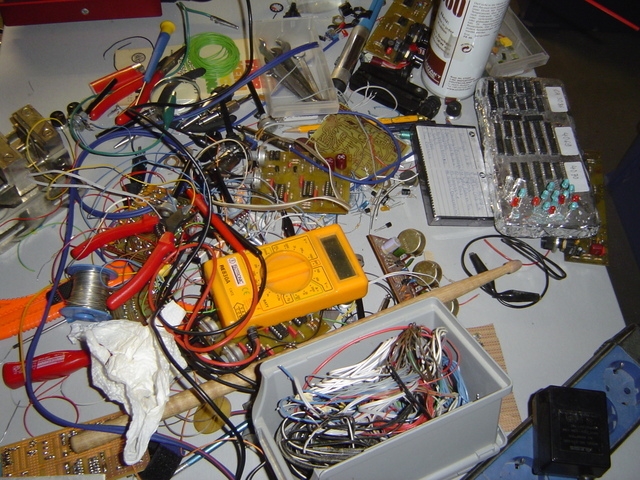
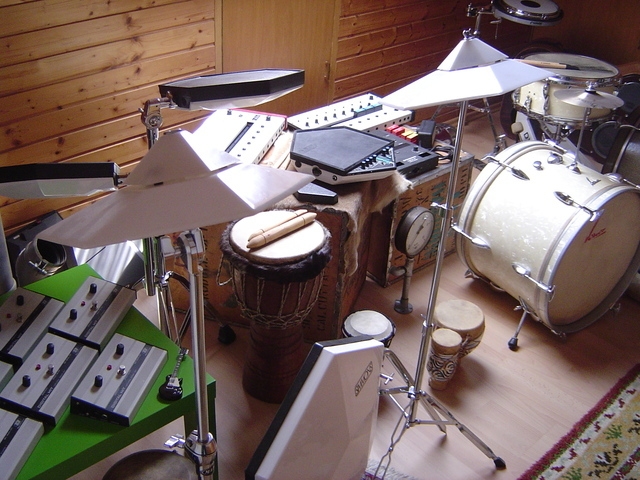
Michael loves to develop and optimize things: For example he showed us the current stage of a single channel SDS3 clone optimized for use with mesh pads:

One of his past inventions is an acoustic drumset similar to a cajon but with real drum heads formed like the body of an acoustic guitar:

Some more impressions
A complete collection of Dynacord Percuter sounds:

Why necessarily round mesh pads? Prototype of a hex-shaped mesh head bassdrum

Michael explaining the main board of an old Siel synth:

UV light to clear eproms

several designs of circuit boards:

Sonor Mamut pad:
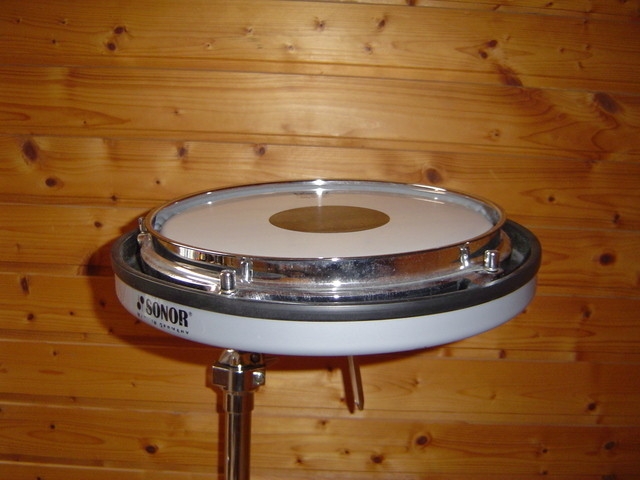
Dynacord Add-One and P-20
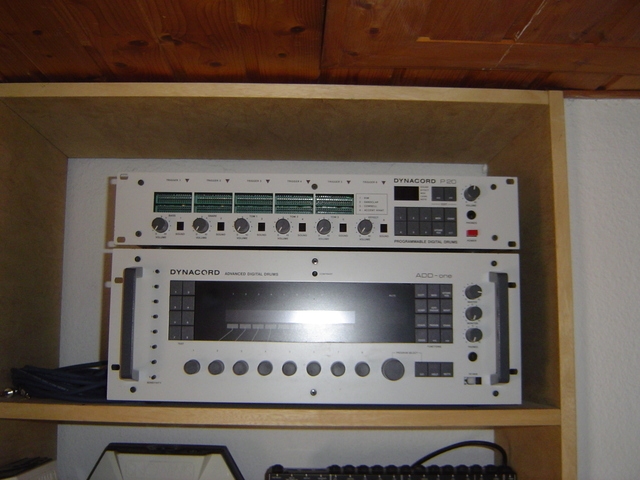
Roland TR-909

Fricke MFB-512

SDS3 clone with self developed analog cymbal module (left):
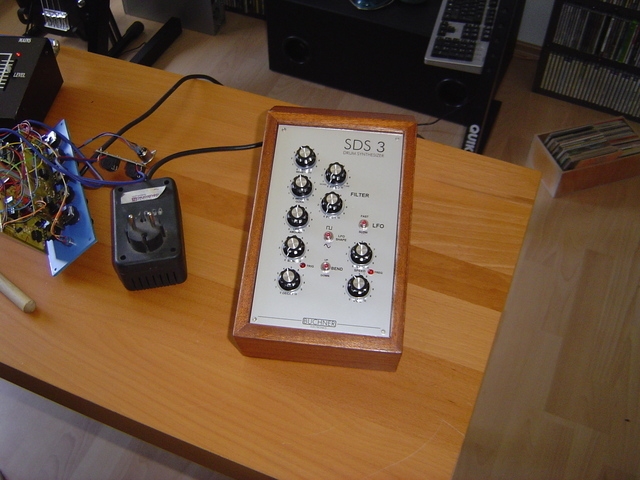
Well-fed, happy and overloaded by all the impressions of the day Oli and me started our journey back home. Next year I will suggest Michael Buchner for the “Synth Nobel Prize”
To be continued……
Posted in Report, Stories and Gossip | 1 Comment »
Suitcase kit and Musicaid SDSV
Friday, October 9th, 2009Yesterday I got an email by Earl Harvin, professional drummer. One of his last projects was the latest Pet Shop Boys album “Fundamental”. He sent some pictures of his suitcase kit and a very early SDSV brain given to him by Lol Creme (10CC, Godley and Creme):

Some facts and tales about the suitcase:
Dave Simmons only built around 15 suitcases, all by hand! I have seen some with Alumium edges and some in black plastic suitcases (like my one). The black suitcases are said to come from a local angler requirements store, but this is not proved. The suitcase got pretty well known by the band Saga who integrated the suitcase into a famous drum solo/drum battle between Michael Sadler (singer/suitcase) and Steve Negus (drums)
Musicaid SDSV
The first SDSV kits had been produced even before “Simmons Electronic Drums” had actually been founded. The early SDSVs do not only show the “Musicaid” logo on the back side as well as on every module, they also have red pushbuttons (instead of black ones) to switch the sounds:
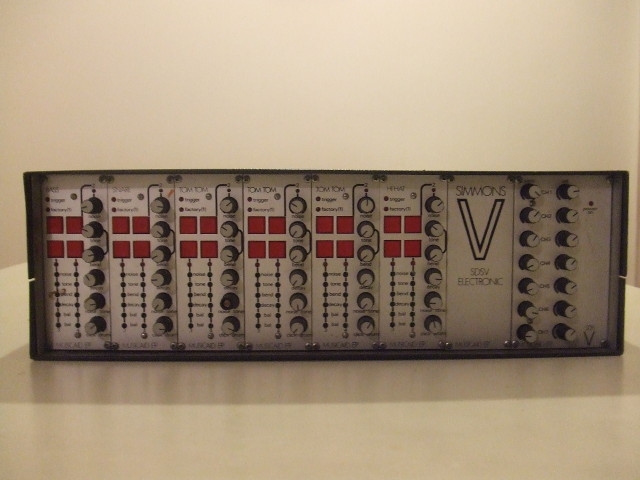
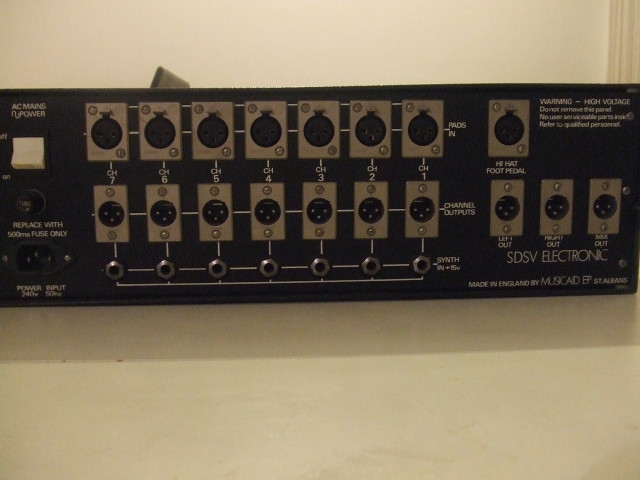
The old Musicaid company got bankrupt in 1981 (although the sales showed an amazing positive tendency) but after a short production break “Simmons Electronic Drums” has been founded and the SDSV became very famous.
Posted in Brains, Pads, Stories and Gossip | 4 Comments »
Another visitor in my Simmons museum
Tuesday, October 6th, 2009Today Jan M. from Cologne visited me. Being only a few years older than me we both grew up with Simmons drums. He is also a mad collector like I am, but today he focusses more on acoustic gear. Still he loves Simmons drums as they had been part of his young carrier as a musicain. We talked a lot, not only about Simmons, but also about the old Techstars, Dynacord and today’s development in electronic drums.
After several gallons of coffee we agreed to meet again very soon, at least I offered him the unique opportunity to play on an SDSV
Posted in Report, Stories and Gossip | Comments Closed

